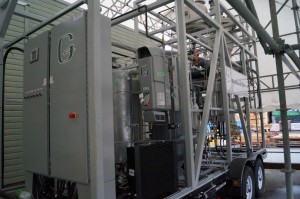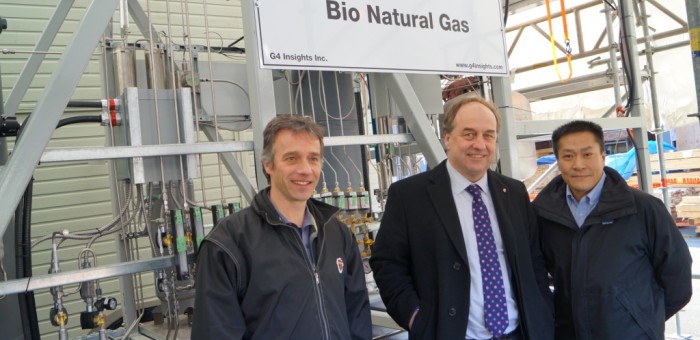Environment
Press conference with Neil Young, Chief Allan Adam, David Suzuki & Eriel Deranger
Today Neil Young kicked off his Canadian Honour the Treaties tour in Toronto. The tour is raising support for the Athabasca Chipewyan First Nations (ACFN) legal defense fun. ACFN are asking Canadians to respect their Treaty 8 rights under section 35 of the Constitution Act, 1982:
Section 35:
- The existing aboriginal and treaty rights of the aboriginal peoples of Canada are hereby recognized and affirmed.
- In this Act, “aboriginal peoples of Canada” includes the Indian, Inuit, and Metis peoples of Canada.
- For greater certainty, in subsection (1) “treaty rights” includes rights that now exist by way of land claims agreements or may be so acquired.
- Notwithstanding any other provision of this Act, the aboriginal and treaty rights referred to in subsection (1) are guaranteed equally to male and female persons.
The ACFN drawing a line in the sand and arguing that unbounded growth of tar sands expansion is unsustainable. They are calling on industry to follow through on their promises to reclaim the land once it is mined instead surging forward unchecked. The ACFN are not calling for a shut down of the tar sands but rather want to see a more responsible path towards development and promised reclamation.
At 13:00 we held a press conference hosted by David Suzuki. Neil Young, Chief Allan Adam, David Suzuki, Eriel Deranger and I each gave a short presentation.
Below is the text of my statement:
“In 1997 the Kyoto Protocol to the United Nations Framework Convention on Climate Change was adopted. Canada played an important role in negotiating the protocol and in 2002 ratified it. We committed to reduce our GHG emissions by 6% relative to 1990 levels by 2008-2012. While 192 nations are still parties to the Kyoto Protocol, Canada formally withdrew in 2012.
In 2007 the Harper government announced that it planned to develop a “Made in Canada” solution to greenhouse gas reductions — a 3% reduction of Canadian GHG levels relative to 1990 by 2020.”
Then in 2010 Canada announced that it would match US emission reduction targets. In the Canadian context, this meant increasing GHG emissions to be 2.5% above 1990 levels by 2020. This was in response to the 2009 Copenhagen Accord wherein nations submitted voluntary reduction targets with the goal of keeping global warming to less than 2°C above preindustrial levels.
But here’s the reality. The world has already warmed by about 0.8°C since preindustrial times. We are committed to a further warming of about 0.6°C as the climate system equilibrates to existing greenhouse gas levels, and about another 0.3°C this century through the permafrost carbon feedback. That’s a total if 1.7°C.
Even if every country met its voluntary GHG reduction target submitted to the Copenhagen Accord, we will almost certainly break the 2.0°C number with even odds that we’d break 3°C this century, with 4°C following shortly thereafter if emissions aren’t curtailed.
Without any doubt, there is a profound disconnect between science and policy.
The Alberta tar sands represent the fastest growing source of Canadian greenhouse gas emissions. We cannot hope to even meet our latest voluntary target unless continued growth in these emissions is curtailed.
In the process of trying to squeeze that last drop of oil out of the ground, we are going to greater and greater extents, with more and more profound environmental consequences. And the Alberta tar sands represent the poster child for environmental destruction and degradation that arises.
Canada is missing out on the next technological revolution — the clean tech revolution. Clean tech is the sector involved in the generation, transportation, storage and end use of renewable energy. While nations around the world are positioning themselves as leaders in tomorrow’s clean tech economy Canada is instead doubling down on yesterday’s economy — the economy of fossil fuels.
We’re entering an exciting age of innovation as we develop the means and ways of generating, transporting, storing and using clean, renewable energy. Let’s unleash our home-grown Canadian innovation. All the solutions to global warming are within our reach.”
Grizzly Bear Trophy Hunting Must End
Despite the objections of Coastal First Nations, and the majority of British Columbians, the provincial government is considering expanding areas where grizzly bears can be hunted.
A study conducted by the Centre for Responsible Tourism, and funded by Tides Canada, concluded that bear watching ecotourism is more profitable than trophy hunting.
In a BC1, Global News interview on ‘Unfiltered’ hosted by Jill Krop, Andrew Weaver takes on the BC Outfitters Association over the economic, environmental and moral arguments of grizzly bear trophy hunting.
View the video here.
Media Release – BC Greens call for 6th condition – No DilBit on BC Coast
Media Statement December 19, 2013
BC Greens call for sixth condition for heavy oil pipelines
For immediate release
Victoria BC – In response the NEB Joint Review Panel’s final decision to approve Enbridge’s Northern Gateway Pipeline, BC Green Party MLA for Oak Bay-Gordon Head, Andrew Weaver, and BC Green Party Leader Adam Olsen are calling on the BC Government to establish a 6th condition for support of heavy oil pipeline projects: A moratorium on dilbit transport along the B.C. coast.
“We are quite disappointed with the JRP report in respect to the risks related to dilbit,” says Andrew Weaver. “The key issue is dilbit because it’s different from refined oils that float on the surface–up to 50% of dilbit sinks making clean-up significantly more difficult if not impossible. We have no way of knowing what would happen if dilbit were to spill on our coast. The science isn’t there to allow for effective spill response and this was not reflected in the report.”
According to the report “Northern Gateway and other hearing participants did not agree on the behaviour of diluted bitumen spilled into water.”
Meanwhile, the Department of Fisheries and Oceans has made it clear that “Behaviour models specific to dilbit spills do not exist, and existing commercial models for conventional oil do not allow parameter specific modifications.”
“Clearly the report did not do an adequate job of addressing the risks of dilbit on our coast.” says Adam Olsen. “We have a choice as British Columbians: We can continue to play Russian roulette with our pristine coastline, or we can stand up for British Columbia and put a moratorium on dilbit transport along our coast.”
Mat Wright – Press Secretary Andrew Weaver MLA
mat.wright@leg.bc.ca
1 250 216 3382
Media Statement: Northern Gateway Conditional Approval ‘Deeply Disturbing’
Media Statement December 19, 2013
Northern Gateway, Joint Review Panel – Conditional ‘Yes’
For immediate release
Victoria BC – Today the National Energy Board’s Joint Review Panel released its report to the Federal Cabinet on Enbridge’s proposed Northern Gateway Pipeline. The panel’s conditional ‘yes’ is deeply concerning, considering the opposition by the BC Government, First Nations, environmental groups and the majority of the people of the province.
However, it is the 209 conditions that apply for the project to proceed which require emphasis. The Federal Cabinet must ensure that these conditions will be fully met before approving the project. It is unclear how the marine spill response conditions can be fully met, given the lack of scientific research and understanding of how diluted bitumen behaves in a marine environment.
“To date, not a single oil spill response study has adequately accounted for what would happen if DilBit were to spill in the ocean. The BC Government has said they require world class, effective spill response capacity, but don’t yet know how they will evaluate this. How can we possibly gauge how well prepared we are for a DilBit spill if the science, the studies and the evaluative criteria don’t even exist?” Andrew Weaver MLA
The question remains if the recommendations will meet the five requirements outlined by the BC Government, or even if the Northern Gateway Project itself can satisfy the conditions outlined by the Joint Review Panel. The Union of British Columbia Indian Chiefs remain firmly opposed, and their participation is vital for the project to move forward.
“It is deeply concerning that the Joint Review Panel has recommended the approval of the Northern Gateway Pipeline. The vast majority of British Columbians have made it clear they are opposed to the pipeline. My question to the Christy Clark is: Will you stand up for BC like you promised during the election and stop this pipeline, or will you stand by while the Federal government impose its will on our province?” Adam Olsen, Interim Leader BC Green Party
Mat Wright – Press Secretary Andrew Weaver MLA
mat.wright@leg.bc.ca
1 250 216 3382
Jobs, Economy and Northern Gateway
Photo above: Matt Babicki and Edson Ng, G4 Insights Inc.
The National Energy Board’s Joint Review Panel (JRP) has now released its final report approving the Enbridge Northern Gateway pipeline project. The project would see 525,000 barrels of the heavy oil diluted bitumen (dilbit) transported across British Columbia each day and loaded onto super tankers for shipment to international refineries. The project is yet another manifestation of a pattern of digging up Canada’s raw resources and shipping them to other countries with no value-added manufacturing or refining done locally. Yet what makes this proposal particularly problematic is the significant economic and environmental risk that we in B.C. face, should a spill occur.
If you look at the numbers, B.C. is projected to receive roughly $1.2 billion in tax revenue from the Northern Gateway pipeline over the span of 30 years—that’s only $40 million a year towards a $44 billion provincial budget. Yet, according to the UBC Fisheries Economic Research Unit, the economic cost of a single major tanker spill is estimates to be between $2.4 and $9.5 billion—that’s between 2 and 8 times more than the total 30-year economic benefit of the pipeline—in one spill.
Meanwhile, to date no oil spill response study has been able to account for dilbit; studies have only analyzed what would happen in the case of a spill from more commonly shipped crude oil. Unfortunately dibit is unlike other crude oils in that whereas most oils will float on the surface, up to 50% of dilbit will sink. Once that happens, we don’t know where it will go, how it will interact with currents and tides or how we could reasonably clean it up. In some areas it is projected that only 3% of floating crude oil could be cleaned up in the event of a spill. That number is already dismally low. With dilbit it would be even lower. According to the Department of Fisheries and Oceans’ own recent submission to Treasury Board: “Behaviour models specific to dilbit spills do not exist, and existing commercial models for conventional oil do not allow parameter specific modifications.”
Yet, we have an opportunity now to shift away from our old economic model of selling our raw resources solely for short-term profit and instead position ourselves for the long-term.
Let me offer two examples.
If we are going to develop the tar sands, and if we must transport oil along our coast, then at the very least let’s refine it first. This would offer two benefits: First, it would offer greater economic benefit for all British Columbians, as we would benefit from a value-added refining and spin-off petrochemical industry instead of shipping those jobs to Asia. Second, it would significantly decrease the environmental impact of a marine-based oil spill, as refined oil products (such as gasoline, diesel, or jet fuel) are much easier to clean up than dilbit. Let me be clear, this on its own is not an ideal solution and it does not protect us from the ecological consequences of a marine-based oil spill, but it certainly mitigates the risk when compared to shipping dilbit.
 However, building a future economy based solely on the exploitation of a depleting resource will not steer us towards the low-carbon pathway that so many other nations are choosing to follow. That’s why British Columbia should seize the opportunity of promoting the expansion of our clean technology (cleantech) industry. With our abundance of renewable natural resources, our highly educated workforce, our-business friendly tax structure and our reputation for innovation, British Columbia is uniquely positioned to become a leader in this sector—a sector that focuses on the production, storage, transmission and end-use of renewable energy. Just yesterday I toured Burnaby-based G4 Insights Inc’s portable thermochemical facility designed to produce compressed natural gas for vehicular transport from wood waste. We need to grow our nascent cleantech companies, like G4 Insights, rather than allow them to be scooped up and exported to the US. The cleantech sector offers long-term, high-paying and local jobs. Yet developing this industry to its full potential requires the market to be sent a strong signal from government that this is the direction we want to head.
However, building a future economy based solely on the exploitation of a depleting resource will not steer us towards the low-carbon pathway that so many other nations are choosing to follow. That’s why British Columbia should seize the opportunity of promoting the expansion of our clean technology (cleantech) industry. With our abundance of renewable natural resources, our highly educated workforce, our-business friendly tax structure and our reputation for innovation, British Columbia is uniquely positioned to become a leader in this sector—a sector that focuses on the production, storage, transmission and end-use of renewable energy. Just yesterday I toured Burnaby-based G4 Insights Inc’s portable thermochemical facility designed to produce compressed natural gas for vehicular transport from wood waste. We need to grow our nascent cleantech companies, like G4 Insights, rather than allow them to be scooped up and exported to the US. The cleantech sector offers long-term, high-paying and local jobs. Yet developing this industry to its full potential requires the market to be sent a strong signal from government that this is the direction we want to head.
Today’s JRP’s decision is simply a recommendation to the Federal Government. Ultimately it will be Prime Minister Stephen Harper and his cabinet who decide if the Northern Gateway pipeline project is approved. My challenge to both our Federal and Provincial governments is this: Let’s keep dilbit out of our coastal waters, keep the jobs in Canada, and position ourselves for tomorrow by building Canada’s capacity for cleantech.








